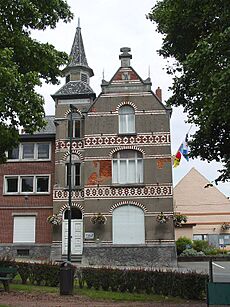Wezembeek-Oppem facts for kids
Quick facts for kids
Wezembeek-Oppem
|
|||
|---|---|---|---|
 |
|||
|
|||
| Country | Belgium | ||
| Community | Flemish Community | ||
| Region | Flemish Region | ||
| Province | Flemish Brabant | ||
| Arrondissement | Halle-Vilvoorde | ||
| Area | |||
| • Total | 6.82 km2 (2.63 sq mi) | ||
| Population
(2018-01-01)Lua error in Module:Wd at line 1575: attempt to index field 'wikibase' (a nil value).
|
|||
| • Total | Lua error in Module:Wd at line 1,575: attempt to index field 'wikibase' (a nil value). | ||
| Postal codes |
1970
|
||
| Area codes | 02 | ||
| Website | www.wezembeek-oppem.be | ||
Wezembeek-Oppem is a town in Belgium. It is a municipality located in the province of Flemish Brabant. This area is part of the Flemish region of Belgium.
Wezembeek-Oppem is about 10 kilometers (6 miles) east of the center of Brussels, the capital city. It is mostly a suburb of Brussels. In 2016, about 14,095 people lived there. The area is 6.82 square kilometers (2.63 square miles). This means about 2,066 people live in each square kilometer.
The Brussels Ring (R0), which is a big highway around Brussels, goes right through Wezembeek-Oppem. Many people from other countries live here. This is partly because of two international schools nearby. The Internationale Deutsche Schule Brüssel (German School) is in Wezembeek-Oppem. The British School of Brussels is in nearby Tervuren.
Contents
Languages in Wezembeek-Oppem
Wezembeek-Oppem is one of six special towns in the Flemish Region. These towns are around the Brussels-Capital Region and have "language facilities." This means they offer services in more than one language.
Wezembeek-Oppem is the only one of these towns that does not directly touch Brussels. A small strip of land from the town of Kraainem is between Wezembeek-Oppem and Brussels.
In 1947, nearly 30% of the people in Wezembeek-Oppem spoke French as their first language. In 1963, Belgium set up official language borders. Wezembeek-Oppem became officially Dutch-speaking. However, it also had special services for French-speakers.
Today, the official language is Dutch, like everywhere else in Flanders. But because of its "facility status," people can ask for official papers in French. They can also get primary school education in French and use some other public services in French.
Wezembeek-Oppem During World War II
During World War II, when Nazi Germany occupied Belgium, there was an orphanage in Wezembeek. This orphanage was for Jewish children whose parents had been harmed or killed.
In August 1944, a group called the Comité de Défense des Juifs helped to hide these children. They moved the children to Catholic schools, other orphanages, and different safe places. This was done to protect them from the Nazi forces.
During a big battle in December 1944 and January 1945, the children stayed safe. They hid in basements of homes and schools. These places were sometimes occupied by Nazi troops fighting against the Allied forces. Many children from the orphanage survived this difficult time.
Schools in Wezembeek-Oppem
Wezembeek-Oppem has several schools. The International German School of Brussels is located here. Another school in the municipality is the Heilig Hart College.
See also
 In Spanish: Wezembeek-Oppem para niños
In Spanish: Wezembeek-Oppem para niños





